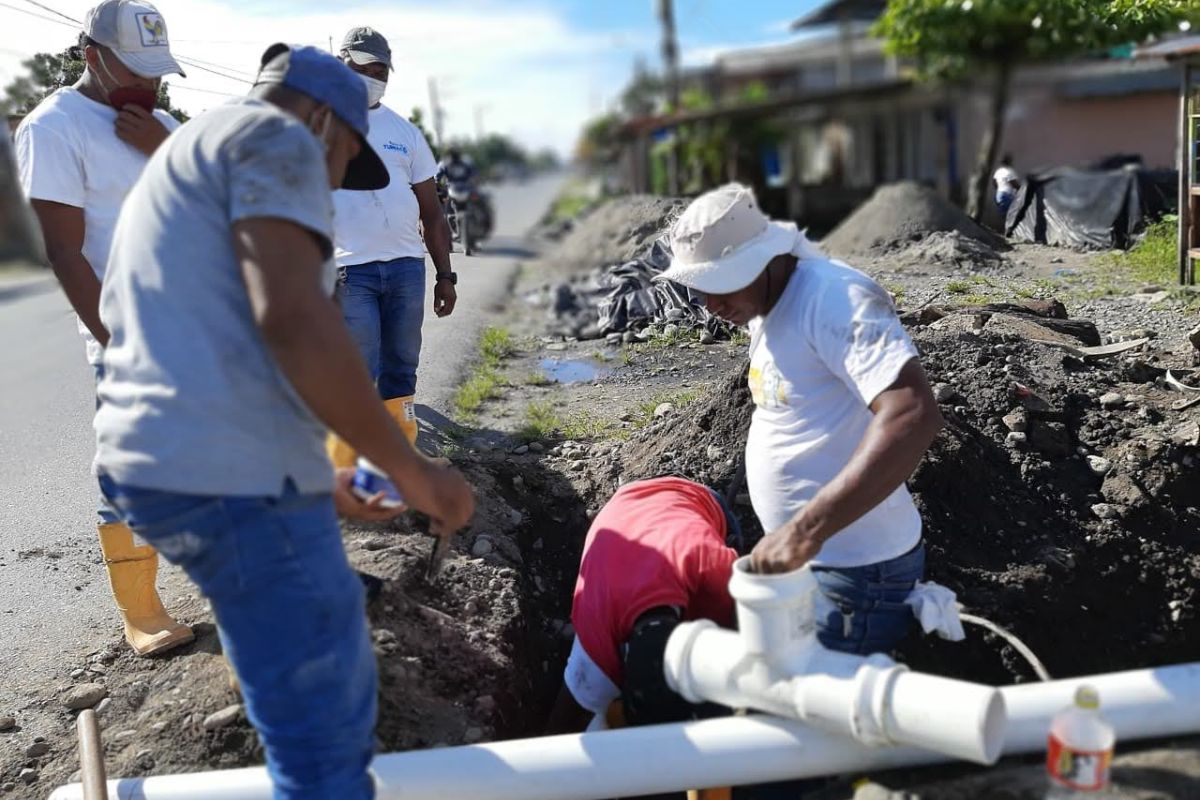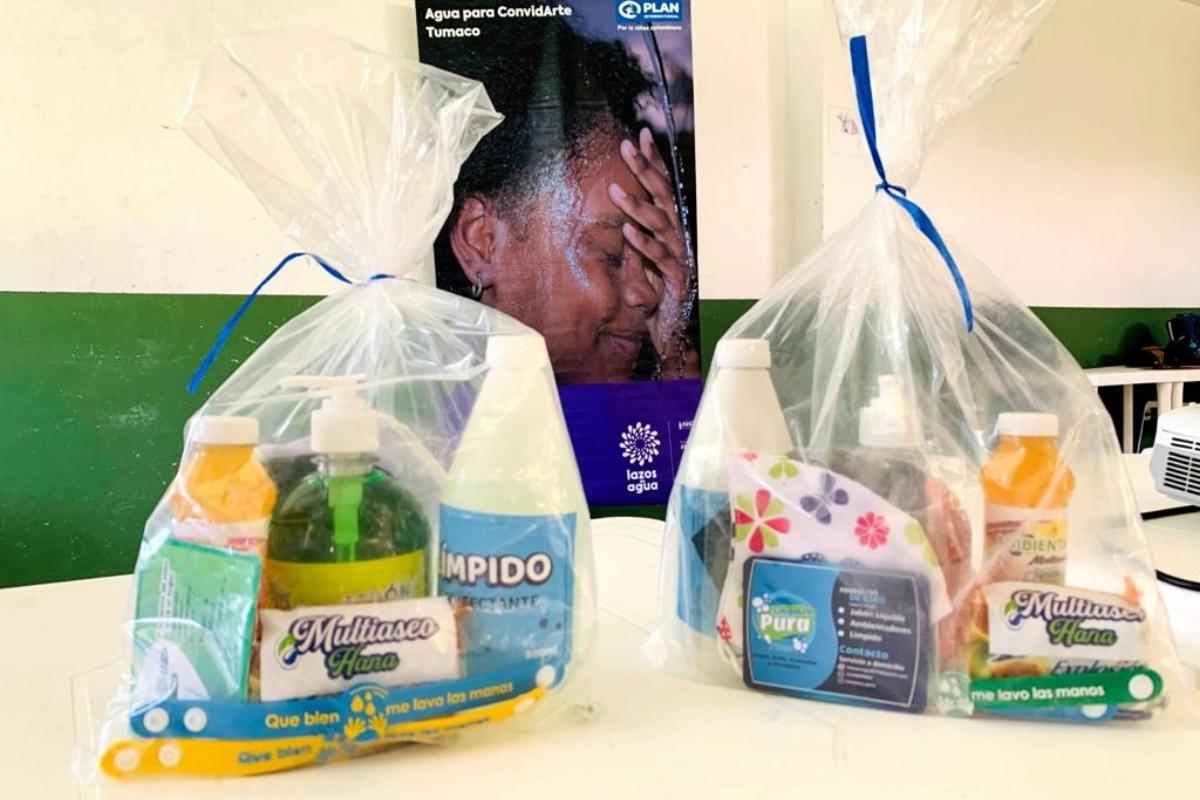Case Study, Agua para ConvidArte
The Lazos de Agua program, through the Agua para ConvidArte project in Tumaco, designed a strategy to strengthen the WASH sector and empower communities during the pandemic.
Executive Summary
Key facts about the case study
The first phase of the strategy for the delivery of cleaning kits was carried out with Micro, Small & Medium Enterprises (MSMEs) that are manufacturers of cleaning products, supported technically and financially by the Agua para ConvidArte Project in Tumaco.
Problem
Need for WASH Sector Strengthening during the COVID-19 Pandemic.
Solution
Delivery of cleaning kits in the communities served.
Results
Marketing support to MSMEs during the pandemic, strengthening the local economy while promoting the adoption of key WASH behaviors.
Introduction
Using the One Drop Foundation's A‧B‧C for Sustainability™ model, the PLAN Foundation implemented the project Agua para ConvidArte Tumaco. In this initiative, all actors in the WASH (Water, Sanitation and Hygiene) sector are integrated. Component A aims to provide access and/or improve water and sanitation infrastructure, component B aims to change behavior with Social Art in the communities, and component C, for capital, aims to promote the local economy by strengthening the value chain.
Background - What motivated the initiative?
- COVID-19 arrived in Colombia in 2020, as it did in the rest of the world. This virus, which gradually began to spread, reached all corners of the national territory.
- Agua para ConvidArte Tumaco, of Colombia's Lazos de Agua Program, seeks to improve living and health conditions by promoting strategies for strengthening Water, Sanitation and Hygiene. The pandemic presented an opportunity for communities to respond and reduce the risk of contagion.
- Although the Agua Lazos Program is not designed to address or respond to emergencies, through the integration of components A and C (Access and Capital) of the A‧B‧C for Sustainability model , as well as the Social Art for Behavior Change™ (SABC) approach, with the delivery of hygiene kits the project found a strategy to promote the practice of key behaviors addressed in the project (in particular handwashing with water and soap).
Objectives

Objective 1
Design a promotion and positioning campaign for MSMEs supported by the Agua para ConvidArte project.
Objective 2
Empowering communities and especially Agents of Change.
Objective 3
Promote the adoption of healthy behaviors in the communities participating in the project.
Problem Statement
As in other countries in the world, the arrival of COVID-19 brought serious economic and social problems to Colombia, while health problems caused by the virus were being addressed.
As part of the Lazos de Agua Program, and driven by Component C, Capital, of the project, the idea was to strengthen the region's MSMEs and expand their market by delivering hygiene kits with products manufactured by them.
Given these circumstances, the decision was made to deliver these kits in order to not only support the sanitation crisis by supplying hygiene items for proper hand washing, but also to strengthen and expand the marketing of the products of these MSMEs.
Solution
The delivery of the kits was not made as a donation to the families participating in the project, nor as a strategy of assistance or response to the health emergency, but as a marketing campaign for the first MSMEs technically and financially supported by Agua para Convidarte Tumaco.
This gave them the tools to position themselves in the market, make themselves known, increase their number of clients, improve their sales and, therefore, their quality of life and that of their families, while at the same time providing a solution to the families and community members affected by the sanitation crisis.
1. Component A, Access
In the first phase for the delivery of hygiene kits, it was necessary to establish the communities in which they would be delivered, defining the structure and quantities. For this, it was decided that the kits would be delivered to each of the homes that were connected to the water supply network and in the communities where the systems were optimized or built.
Thus, a list was made in which the communities and the number of connected houses were determined to carry out the deliveries.

2. Component B
Considering that the kits to be delivered would have liquid hand soap, with the objective of promoting hand washing behavior, an opportunity was seen to integrate the process by generating an element that would serve as a reminder (bracelet) for the realization of this behavior as a product of Social Art.
This also made it possible to integrate Agents of Change from the planning stage to the delivery of the kits, thanks to the work they carried out and the leadership they exercised in their communities.
As with all Social Art products, it was necessary to involve the community in the process and, with the support of an artistic group, to guide them and define the target community to which the reminder would be addressed.
Initially, it was determined that the target group would be children between 9 and 12 years of age, who would motivate their peers and caregivers to practice the behavior, so it was necessary to identify an artistic group with experience in this audience to assist in the process.
Thus, the Lazos de Agua Program, together with the PLAN Foundation and the artistic group, created a guide with a clear objective: "To increase the presence of handwashing reminders in different environments for children between 9 and 12 years of age in their homes". The aim was to build a Social Art reminder for handwashing behavior change in a participatory manner with children and influencers.
This exercise was led by the artistic group Maestros del Entretenimiento with children and parents in four of the project's beneficiary communities. There, the Agents of Change were key players in helping to gather the participants and setting up, among other things, the meeting place.
To implement this methodology, and given the working conditions due to the pandemic, focus groups were held in which several ideas resulted from what this reminder could be, for example, puppets, calendars, and other elements. Finally, the element chosen was a bracelet.
This space where children and influencers gathered to get the bracelet, became a stage for art, culture, and knowledge. There, songs, rhymes and verses were created, based on the behavior of hand washing.


3. Component C, Capital
Considering that the delivery of these kits would not be in response to the emergency, an agreement was reached with the micro-enterprises so that this strategy would work from a marketing perspective that would help them in the process of positioning their brands in the CENIZA market of Tumaco.
The project supplied the raw materials for the manufacturing of the products that would make up the hygiene kits and the logistics to reach the communities.
Once the communities and products to be delivered were determined, the MSMEs Multiaseo Hana and Limpieza Pura were selected to be supported, after the proposal was accepted.
Let’s get to work, let's deliver!
With the hygiene kits assembled, the bracelet as a reminder, and the communities chosen, it was determined that the delivery would be made according to the number of houses connected, i.e., if a house had two floors but only one connection to the aqueduct network, it would receive one hygiene kit.
As with all Social Art for Behavior Change products, Agents of Change played an important role in determining how the delivery and routing would take place in their communities.
Prior to the door-to-door delivery of the kits, a meeting was held with neighbors and members of the communities to discuss the behavioral changes. In addition, other Social Art products were presented, such as the Chucuchú ¿usted está peye? music video.
On the other hand, in this meeting space, the micro-entrepreneurs saw the opportunity to present their businesses to the community, so they talked about the content of the kits and the use of each of the products included.
Besides hand washing, which was the main objective, these meetings were also used to promote the behavior of treating water for drinking at home through the chlorinated method, since the kit included a cleaner (bleach) which, besides being a cleaning and sanitizing agent for surfaces widely used by housewives, can also chlorinate water.
“Getting this hygiene kit will help me a lot. Everything they gave us is very useful. Also, it will teach us the technique for hand washing. We used to put our hands in a container with water, but we understood that the correct way to do it is to let the water run", said Mercy Liliana Grueso, a resident of the community.
At the end of this knowledge-sharing space, the Agents of Change along with a representative of the MSMEs organized groups of deliveries by zones, depending on where the door-to-door deliveries were being made. While the talks were being given on the importance of hand washing with soap and running water, the Agents of Change also taught children how to wash their hands properly, while the micro-entrepreneurs presented the contents of the kit, the benefits of the products and established links with future buyers.
What's in the kit?
The kit included one liquid hand soap, one body bar soap, one air freshener, one bottle of bleach and two reminder bracelets for children between 9 and 12 years of age.
For this process, the owners of the MSMEs decided to join forces and work as a team to manufacture the products.
Given the initial objective of positioning the micro-enterprises at the time of assembling the kits, free samples of their products and business cards were handed out to facilitate home delivery orders, an action that has allowed them to generate new customers and reach more places within the territory.

Results, achievements, and impact
Conclusion
- The Agents of Change were recognized in their communities for the work they do in promoting behavioral changes such as hand washing at key moments and water treatment in the home.
- Men, women, and children learned the importance of washing their hands with running water and soap at key moments and learned that chlorinating is a method for treating drinking water at home.
- The strategy of delivering cleaning kits allowed the micro-entrepreneurs to identify a huge opportunity to expand their market to places they did not reach before and to visualize new ways of promoting their products, such as the creation of combos to broaden their portfolio.

Recommendations
- Consider other MSMEs and populations involved in order to replicate this strategy in other communities where the project is implemented.
- The contribution made by the Agents of Change is very valuable and necessary, since they are people who know their communities, their streets, sectors, neighborhoods and know how to reach their communities so that they adopt behavioral changes and improve their hygiene habits. This makes it possible to identify routes and methodologies for the delivery of the kits.


